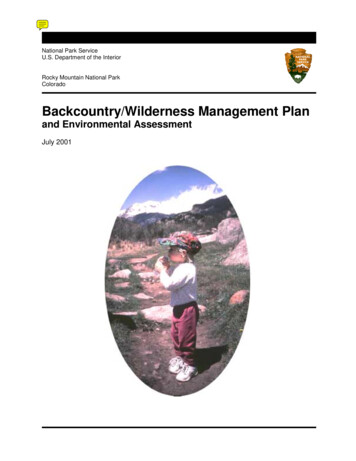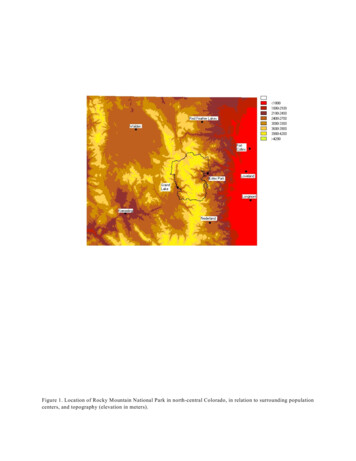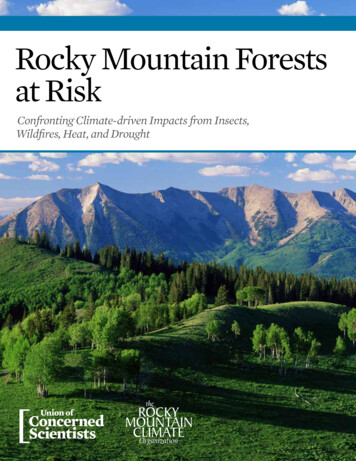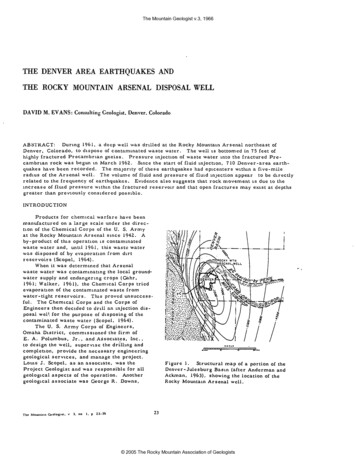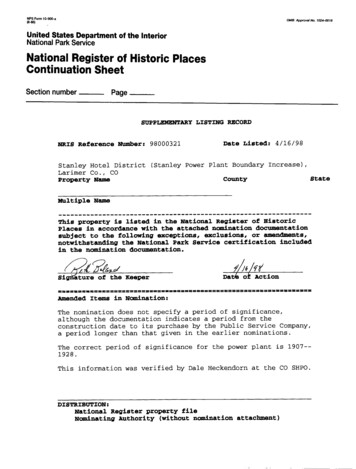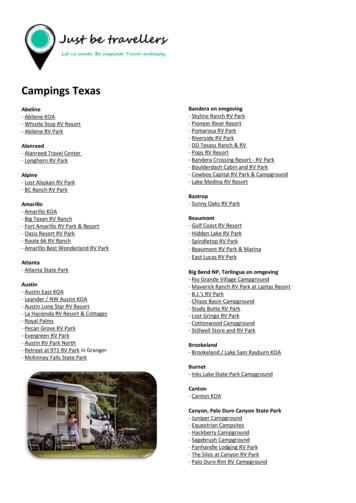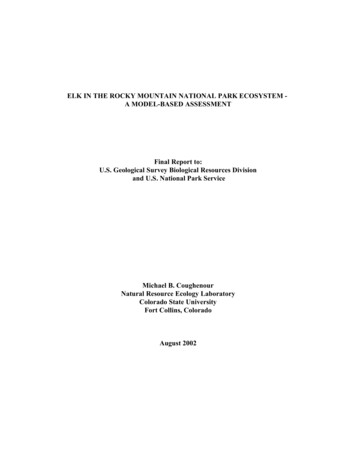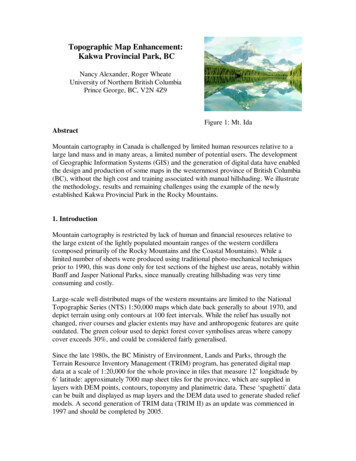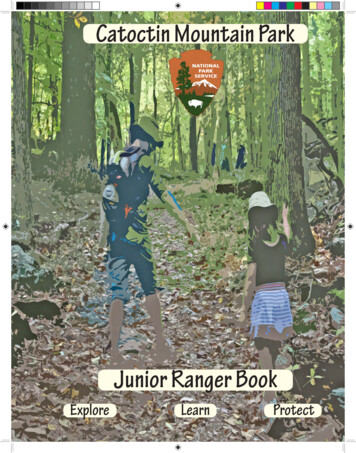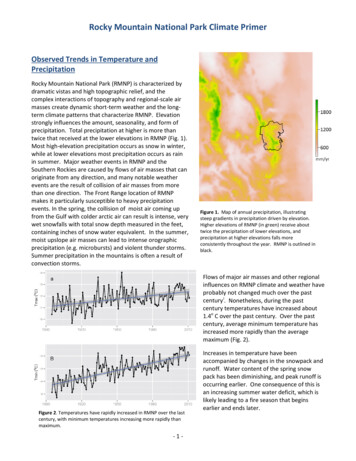
Transcription
Rocky Mountain National Park Climate PrimerObserved Trends in Temperature andPrecipitationRocky Mountain National Park (RMNP) is characterized bydramatic vistas and high topographic relief, and thecomplex interactions of topography and regional-scale airmasses create dynamic short-term weather and the longterm climate patterns that characterize RMNP. Elevationstrongly influences the amount, seasonality, and form ofprecipitation. Total precipitation at higher is more thantwice that received at the lower elevations in RMNP (Fig. 1).Most high-elevation precipitation occurs as snow in winter,while at lower elevations most precipitation occurs as rainin summer. Major weather events in RMNP and theSouthern Rockies are caused by flows of air masses that canoriginate from any direction, and many notable weatherevents are the result of collision of air masses from morethan one direction. The Front Range location of RMNPmakes it particularly susceptible to heavy precipitationevents. In the spring, the collision of moist air coming upfrom the Gulf with colder arctic air can result is intense, verywet snowfalls with total snow depth measured in the feet,containing inches of snow water equivalent. In the summer,moist upslope air masses can lead to intense orographicprecipitation (e.g. microbursts) and violent thunder storms.Summer precipitation in the mountains is often a result ofconvection storms.Figure 1. Map of annual precipitation, illustratingsteep gradients in precipitation driven by elevation.Higher elevations of RMNP (in green) receive abouttwice the precipitation of lower elevations, andprecipitation at higher elevations falls moreconsistently throughout the year. RMNP is outlined inblack.Flows of major air masses and other regionalinfluences on RMNP climate and weather haveprobably not changed much over the pastcentury i. Nonetheless, during the pastcentury temperatures have increased about1.4o C over the past century. Over the pastcentury, average minimum temperature hasincreased more rapidly than the averagemaximum (Fig. 2).Figure 2. Temperatures have rapidly increased in RMNP over the lastcentury, with minimum temperatures increasing more rapidly thanmaximum.-1-Increases in temperature have beenaccompanied by changes in the snowpack andrunoff. Water content of the spring snowpack has been diminishing, and peak runoff isoccurring earlier. One consequence of this isan increasing summer water deficit, which islikely leading to a fire season that beginsearlier and ends later.
Projected 21st Century ChangesAll global climate models (GCMs) are consistent inprojecting temperature increases throughout the RockyMountains and adjacent areas. Increases in temperaturesare projected to lead to an increase in extremely hotweather spells, and a decrease in cold spells (Table below).Projections for changes in precipitation are less certain, withlarge variations between models and with large year-to-yearchanges in the amount of rain and snow.Increasing temperatures will lead to earlier snowmelt,especially at lower elevations, and an earlier runoff. Rain onsnow events may be more likely, and most projectionsinclude more extreme precipitation events.-2-
Impacts of Projected Climate ChangeExplosive growth to pine beetlesOne of the most apparent change in RMNP forests isthe result of tree mortality caused by mountain pinebeetles (picture at right). Native pine beetleshistorically produced at a much less rapid rate, andcold winter temperatures limited their distribution andcaused extensive winter mortality. The warmertemperatures in the past several decades have allowedpine beetles to complete an entire generation in oneyear, leading to explosive population growth andmassive tree mortality.Projections for RMNP forests are not encouraging.Conifers in RMNP are subject to attack by a variety offorest pathogens and pests, and climate changes mayproduce additional stressors that make trees moreMountain pine beetles have caused extensive mortality offorest trees in RMNP. Pine beetles are native, buttemperatures now permit rapid reproduction andexplosive population growth.-3-
susceptible.Earlier RunoffMountains provide a key service in storing water in thewinter and releasing it throughout the summer. Over thepast several decades, there has been a significant trend toearlier melt of the snow pack and an earlier peak in snowfed streams and rivers in Colorado. This trends is mostpronounced at lower elevations because these areas arewarmer and this a small increase in temperatures meltssnow.Snow water storage in Colorado has beendeclining for the past several decades,and all models project the trend tosmaller spring snow packs will continue.Figure from Clow 2010)Fire(text on fire seasonality)-4-
29 Tmax (oC) 28 27 19501980Tmin (oC) 11 2010 13 1920 1890 2612 18901920195019802010 300Precip (mm/yr) 200 100 0189019201950Year19802010
29.028.027.026.0Tmax ( 10.5Tmin ( C)13.5Year190019201940196025015050Precip (mm / yr)350Year1900192019401960Year
28.4 28.0 Tmax (oC) 27.6 27.2 190019201940196019802000 13.0 Tmin (oC) 12.5 12.0 11.5 1920 1900 1940196019802000 200 Precip (mm / yr) 150 100 19001920194019601980 2000
1.5SSTmax (oC)1.00.50.0 0.5FWSFSWWFSSFSWWSSSSSFSWSFWWFSWSFSFWFSSWFS 1.0192019401960198020001.5Tmin (oC)1.00.5WSWSFW0.0S 0.5SFWSFFSWSSSWFSWFS 1.019201940SFSFSWFWSS1960SFSSFWSW19802000Precip (mm / yr)1000SSFSSWFFWWWSFSSSFSWFSSFWSSSWSFSFSWWSWSFSFSW 10019201940196019802000
Maximum temp anomoly (C)2 0 2Temp (C) 4 002010Minimum anomoly temp (C)3 2 1 0 2Temp (C) 4 ion anomoly (mm/mo) 10 20 30 40 0 20Precip (mm/mo) 190019101920193019401950196019701980199020002010
28.0 27.0Max Temp29.0 26.0 952005 11.512.5 10.5Min 515050Precip250 190519151925193519451955196519751985
WinterSpring35 302025Max Temp1510Max Temp20 1905193519651995190519351995Fall3025Max Temp3634 20 32Max 95
WinterSpring8 1510Min Temp42Min Temp6 0 25 190519351965199519051935Fall15Min Temp1024222018516Min Temp199520Summer1965 19051935196519951905193519651995
Rocky Mountain National Park Climate Primer Observed Trends in Temperature and Precipitation Rocky Mountain National Park (RMNP) is characterized by dramatic vistas and high topographic relief, and the complex interactions of topography and regional- scale a
